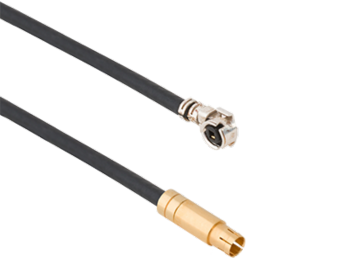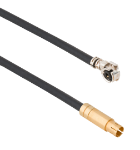Ultra Low Profile U.FL to VITA Cable Assemblies

SV's Ultra Low Profile U.FL-to-VITA Cable Assemblies deliver a compact, high-performance RF interconnect solution designed for dense VPX plug-in card systems and precision test environments. These 6-inch assemblies pair a VITA 67.3 interface — available in NanoRF, SMPM, or SMPS series — with an ultra-miniature U.FL connector featuring a 2.5 mm mated height and 0.079" (2.0 mm) width. The result is a streamlined, space-saving connection that enables direct, low-loss routing from the VITA block to the PCB, optimizing signal integrity in high-frequency applications up to 6 GHz.
Features/Benefits:
- Ultra-low 2.5mm mated height (U.FL connector)
- Narrow 0.079" connector width (U.FL connector)
- Flexible, compact 6" cable length for tight routing
- Available with VITA 67.3 connector series
- DC - 6 GHz
Applications:
- VPX Plug-In Cards for VITA 67.3
- Embedded Systems
- High-density RF modules and assemblies
- Test and Measurement setups
U.FL
| Impedance (Ω) | 50 |
| Frequency GHz | DC to 6 GHz |
| Shielding Effectiveness | Typically > 50 dB @ 1 GHz |
| VSWR | ≤ 1.3:1 max (DC–3 GHz), ≤ 1.4:1 max (DC–6 GHz) |
| Dielectric Withstanding Voltage | 200 V RMS for 1 minute |
| Mating Cycles | 30 Minimum |
| Mating Torque | 7 - 10 in - lbs |
| Insertion Force | 3.5 lbs |
| Withdrawal Force | 1.5 lbs |
| Temperature Rating | −40 °C to +90 °C |
| Corrosion (salt spray) | MIL-STD-202 Method 101, Condition B |
| Vibration | MIL-STD-201 |
| Shock | MIL-STD-202, Method 213, Condition A |
| Thermal Shock | MIL-STD-202 Method 107, Condition A |
| Moisture Resistance | MIL-STD-202 Method 103, Condition B |
VITA SMPM
| Impedance (Ω) | 50 |
| Frequency GHz | 40 GHz |
| Shielding Effectiveness | ≥ -100 dB, DC to 26.5 GHz |
| Dielectric withstanding Voltage | 325 VRMS |
| Mating Cycles | 500 |
| Insertion Force | 2.5 lbs (per contact) |
| Withdrawal Force | 1.5 lbs |
| Temperature Rating | -65°C to +165°C |
| Corrosion (salt spray) | MIL-STD-202, Method 101, Condition B |
| Vibration | MIL-STD-202, Method 204, Condition D |
| Shock | MIL-STD-202, Method 213, Condition I |
| Thermal Shock | MIL-STD-202, Method 107, Condition B |
| Moisture Resistance | MIL-STD-202, Method 106, Less Step 7B |
| Barometric Pressure (Altitude) | MIL-STD-202, Method 105, Condition C, 70k Ft. |
VITA SMPS
| Impedance (Ω) | 50 |
| Frequency GHz | 65 GHz |
| Shielding Effectiveness | ≥ -100 dB, DC to 26.5 GHz |
| Dielectric withstanding Voltage | 250 VRMS |
| Mating Cycles | 500 |
| Insertion Force | 1.2 lbs (per contact) |
| Withdrawal Force | 1.0 lbs |
| Temperature Rating | -65°C to +165°C |
| Corrosion (salt spray) | MIL-STD-202, Method 101, Condition B |
| Vibration | MIL-STD-202, Method 204, Condition D |
| Shock | MIL-STD-202, Method 213, Condition I |
| Thermal Shock | MIL-STD-202, Method 107, Condition B |
| Moisture Resistance | MIL-STD-202, Method 106, Less Step 7B |
| Barometric Pressure (Altitude) | MIL-STD-202, Method 105, Condition C, 70k Ft. |
VITA NANORF
| Impedance (Ω) | 50 |
| Frequency GHz | 67 GHz |
| Shielding Effectiveness | ≥ -140 dB, 3 MHz to 30 MHz ≥ -120 dB, 30 MHz to 3.0 GHz ≥ -100 dB, 3.0 GHz to 30 GHz ≥ -90 dB, 30 to 67.0 GHz |
| Dielectric withstanding Voltage | 250 VRMS |
| Mating Cycles | 500 |
| Insertion Force | 2.5 lbs (per contact) |
| Withdrawal Force | 0.315 lbs |
| Temperature Rating | -55°C to +125°C |
| Corrosion (salt spray) | MIL-STD-202, Method 101, Condition B |
| Vibration | MIL-STD-202, Method 204, Condition D |
| Shock | MIL-STD-202, Method 213, Condition I |
| Thermal Shock | MIL-STD-202, Method 107, Condition B |
| Moisture Resistance | MIL-STD-202, Method 106, Less Step 7B |
| Barometric Pressure (Altitude) | MIL-STD-202, Method 105, Condition C, 70k Ft. |
Product Video
Part # 7083-0115
NanoRF Male VITA 67.3 Plug-In Contact to U.FL Female R/A 6" Cable Assembly for .047 Cable
Available Inventory: 0
7083-0115
VITA Cable Assemblies 7083-0115
Part # 7032-10453
SMPM Male VITA 67.3 Plug-In Contact to U.FL Female R/A 6" Cable Assembly for .047 Cable
Available Inventory: 0
7032-10453
VITA Cable Assemblies 7032-10453
Part # 7038-7593
SMPS Male VITA 67.3 Gen2 Plug-In Contact to U.FL Female 6" Cable Assembly for .047 Cable
Available Inventory: 0
7038-7593
VITA Cable Assemblies 7038-7593









